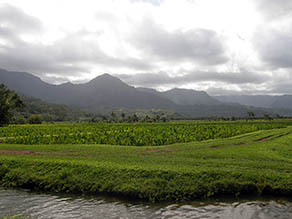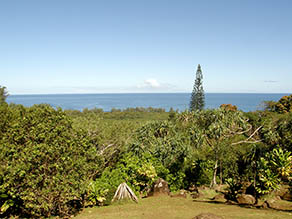 |
 |
 |
 |
||||||
|
|
|
|
|
|
|
|
|
|
|
| People | Environment | Invasives | Food Today | Sovereignty | Language | Sources & Links | |||||||||
 |
|
 |
|||||||
 |

“We have been talking a lot lately about trying to get people excited about preserving the diversity of a forest,” Kawika says. “Because here in our valley, we have fifty or so plants and birds that are on the verge of extinction. Some of them exist only in our valley. How are we going to get our community involved in taking care of that? Because they look up at the mountains, it’s green and they think, ‘Well it’s not concrete, it must be healthy,’ but that’s far from the truth. And so we try to get people to understand that every single native plant in the forest, every single bird, every single fish in the ocean, everything in the stream, every variety of kalo in the fields or the varieties of banana and sugar cane, all of these have names and relationships to the culture. And if one goes extinct, it’s not only just a unit of biodiversity, but we lose all of the traditions and stories that were ever associated with that. “Taro is a good example. As you drive through the fields of Hanalei you see all of that taro, but those are all modern hybrids, they aren’t traditional varieties of taro. What we focus on is, the kūpuna raised the taro that have the old names and the old traditions and the old stories associated with them, so that if there is ever a chance that during our cultural resurgence a particular tradition wants to be re-awakened, then it can be, because we have the plant that’s at the foundation of that tradition. And so that’s kind of what we are focusing on in multiple levels here in Limahuli “You used to hear it a lot in the old days—don’t hear it too much now—the term ‘living off the fat of the land.’ We don’t do that anymore, you don’t even see that. The land is so skinny now, the oceans are skinny, and the mountains are skinny. It’s like we’re just scratching by to even persist as a culture. But in the old days, things were managed so that they were booming. The oceans were booming, the streams were booming, mountains were booming—just overflowing with life. And when you manage the system like that, oh it’s so easy, you just live off the fat of the land. “But when you don’t manage it right, you end up like what we’re doing now in a large scale in Hawai‘i and the world. And so how do we reverse that? How do we change? That is a huge question, but to me, you focus on education programs and the kids. You’re never going to change the bad habits of the mākua and the kūpuna. But if you start instilling in the kids the right way to do things in the context of our traditions, hopefully they can make a change as they grow. That’s what we do. “We’re trying to get the land back to being fat. We learned in the ahupua‘a system that the health of everything is inter-related. If the forest is unhealthy, the stream is going to be unhealthy, the fish in the streams are going to be unhealthy, the fish in the ocean which depends on the health of the streams, are going to be unhealthy. The community who depends on the fishery for its health is going to be unhealthy. And that’s the state that we’re in now. So how do we reverse everything? “In managing this valley, our major kuleana is that the waters flowing out of our valley are clean. So we do a lot of forest restoration work to ensure that, and working with the fishery to make sure that the health of the two are being built up together. Once those are back to a really healthy place again, we will be able to live off the fat of the land again. The sad fact is that the Hawaiian families over here aren’t living off fish and taro. They’re living off white rice and spam or Vienna sausage, and that’s just detrimental to their health and the wellbeing of our entire community. “We have areas where we still have an intact forest and in those areas we do habitat protection. Then in those areas where we have completely degraded forest, we do habitat restoration. The approach is different in both areas. “Fencing is a tool of conservation. Unfortunately, in my humble opinion, it’s been considered as a ‘silver bullet’ by a lot of conservationists. The problem is for communities and indigenous people who don’t have a culture of fences, all that means is exclusion. And so for the past 30 years, conservationists and Native Hawaiians have been, for the most part, bitter enemies. And in my mind, it should be the most natural alliance ever, but it hasn’t been that way and a lot of the reason is because the tools that conservationists have employed. “Hawaiians use fences nowadays, but it’s how the tools have been used. When conservationists come in from outside of the community, into a forest that the people have been engaging with for at least 1,500 years, and put up a fence and say, ‘You guys don’t know what you’re doing, we know what’s best; we have PhD’s so we’re going to do it like this,’ then the Hawaiians get angry and they cut the fences. It’s a downward spiral of broken trust and hurt feelings. In small communities that stuff lasts for generations: ‘You pissed off my grandfather, I’m going to be pissed off with your grand kids.’ That’s just how it works in small communities. “So we’ve been trying to take a different approach and realize a tool is just a tool. There is a right way to use a tool and a wrong way to use a tool. Fences are good tools, but how can we use this tool in a way that it isn’t viewed as exclusionary by the community, that doesn’t cut off access? We still honor the ancestral hunting traditions that started coming in when these animals came in. Conservationists want to say hunting isn’t really high tradition because it wasn’t happening in 1778 when Cook came. “But there’s no dividing line between ‘authentic’ Hawaiian culture and ‘inauthentic’ Hawaiian culture, even though you want there to be one. Cultures evolve, indigenous cultures evolve. Hunting has been a tradition for our people for 150 years, it’s seven generations, at what point does it become a tradition? Seven generations? Come on guys. So part of this involves acknowledging that hunting is now a Hawaiian tradition, it’s part of the Hawaiian identity for a lot of families. Acknowledging that it is the tradition that’s happened in this valley, honoring the relationships with those families for their hunting traditions, but also looking at the seemingly competing interests of needing to build fences to protect plants. “We had this crazy idea of building a fence with the input of the hunting families. Already in 2009 we fenced off the whole upper valley to project that habitat up there. It’s montane cloud forest, pretty intact, lots of critically endangered plants and birds up there—above the waterfall ranging between 1,800 feet and 3,200 feet. It’s what we call upper Limahuli Preserve, but nobody ever hunted up there so it wasn’t a problem. But down here, people still hunted. But we needed to build this fence to protect these plants over there, so I was getting a lot of pressure from Fish and Wildlife to put in the fence and they’re trying to tell me how to do it and where to put it, and I’m like, ‘Hey, come on now, you’ve got to remember this isn’t your land okay? Let me check with the families in the community to make sure they know this is okay.’ “So I approached the families and told them, ‘Okay, we’ve got to do this but there’s got to be a way that we can actually make this fence line so it helps you guys hunt more efficiently.’ I had some ideas and I brought it to them and then we looked at the fence line and we ended up putting in a fence to protect sixty-six acres of rare plant habitat and the fence line is constructed in a way that actually helps the guys hunt. It doesn’t cut off the access, it helps them get the pigs quicker. Which is a win-win for everybody. “We have all these steep ridges and gullies, so we constructed the fence line in association with the ridge lines and the cliffs and all of that. We created these two bottlenecks in the valley, both going into the valley and coming out of the valley. So when the hunters come with their dogs and chase the pigs, they chase them right in the bottleneck and get them. If they’re chasing them up, or if they’re chasing them down, same thing. Michael talks about the explosion of the pig population. “Those novel approaches to fencing using Hawaiian thoughts or involvement, bringing hunters, community members to the decision making table as stake holders, that’s how you use that tool effectively.”
|
 |
|
 |
One of the biggest problems affecting the environment is Invasive Species.
|
 |

|
|
||||
| Copyright 2018 Pacific Worlds & Associates • Usage Policy • Webmaster |
||||











